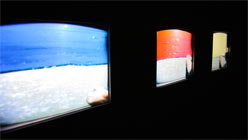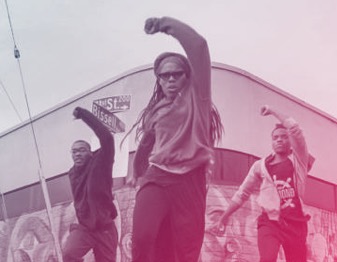As part of their culminating project, the students of the Graduate Program in Curatorial Practice at California College of the Arts wanted to organize an exhibition that highlighted the alternative art spaces and the work these spaces fostered in the Bay Area from the 1970s to the present day. To articulate the most crucial elements of this thesis, they focused on one Bay Area art space of particular value, La Mamelle/ ART COM. By mining the La Mamelle / ARTCOM archive the curators created a nexus of work, ideas, writing and presentation strategies that serves as a contemporary art history lesson and an exciting entry into some of the most challenging performance pieces from the last forty years.
The result, God Only Knows Who the Audience Is: Performance, Video and Television Through the Lens of La Mamelle / ART COM is both an intensely dense and cleverly open-ended exploration of the Bay Area’s relationship to the development of performance and video art using the esteemed La Mamelle / ART COM archive as a through line for the entire exhibition.
From 1975-1995, La Mamelle / ARTCOM was a non-profit artist-run exhibition space in San Francisco. Interested in discovering new forms of art and art making, the organization had its early roots in publishing and art distribution. Soon after, they evolved into an exhibition and performance space showing multiple media, including photography, ephemera, conceptual and video work, as well as hosting screenings and a library. La Mamelle / ARTCOM was also responsible for forming one of the first online artist networks. The name change in 1980 from La Mamelle to ART COM reflects how the organization openly embraced change as they began to confront the relationship between art and technology.

“Explanation Attempt,” Whitney Lynn, 2010.
The exhibition is divided into two levels with each level further divided into conceptual premises. The first galleries start with the body and its absence but then quickly dig deeper and present work that confronts the concepts of both preserving, presenting and even recreating performance work. Whitney Lynn’s 2010 Explanation Attempt, Explanations (Loop), and Forever, from the Doug series is both an homage and a challenge to Joesph Beuys’s 1965 epic performance, How to Explain Pictures to a Dead Hare. In his first gallery exhibition in 1965, Beuys sat in the window of the gallery and described his drawings to the dead hare in his arms. This was a remarkable performance that still holds great resonance for artists today. Lynn’s photographs of herself trying to hold a live rabbit in her arms, and the rabbit fur-covered sweater hung in a frame next to the photographs, is a simple yet sophisticated calling into question how performances can exist after the act. Is preserving the ephemera from performance art or even recreating the performance itself paying tribute to the work or giving it a new life? Is it perhaps a silly exercise, stripping the work of its agency altogether?




